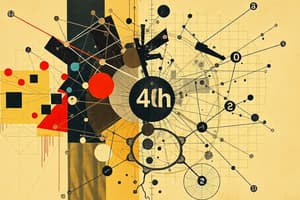Podcast
Questions and Answers
What leads to reactivity in atoms?
What leads to reactivity in atoms?
- Chemical bonds
- Stable electronic configurations
- Incomplete valence shell (correct)
- Inert gases
Which atoms are chemically inactive?
Which atoms are chemically inactive?
- Atoms with stable electronic configurations (correct)
- Atoms forming chemical bonds
- Atoms with unstable electronic configurations
- Atoms with incomplete valence shell
What is the force that binds atoms together to form molecules?
What is the force that binds atoms together to form molecules?
- Chemical bond (correct)
- Electron sharing
- Ionic bond
- Chemical reactivity
How many ways are there for atoms to attain a stable configuration through chemical combination?
How many ways are there for atoms to attain a stable configuration through chemical combination?
What is the term used for the bond formed by complete electron transfer from one atom to another?
What is the term used for the bond formed by complete electron transfer from one atom to another?
What type of compounds contain an ionic bond?
What type of compounds contain an ionic bond?
What type of bond is formed between two atoms in an ionic compound?
What type of bond is formed between two atoms in an ionic compound?
Which statement is true about the melting and boiling points of covalent compounds?
Which statement is true about the melting and boiling points of covalent compounds?
What describes a covalent bond where two atoms share three pairs of electrons?
What describes a covalent bond where two atoms share three pairs of electrons?
Which type of compound is generally lighter than water?
Which type of compound is generally lighter than water?
What type of ion is formed when an atom gains electrons?
What type of ion is formed when an atom gains electrons?
Which process involves the removal or loss of electrons from an atom or ion?
Which process involves the removal or loss of electrons from an atom or ion?
Flashcards are hidden until you start studying
Study Notes
Chemical Bonding
- Atoms tend to combine to attain stable electronic configurations, which leads to reactivity.
- Inert gases have stable electronic configurations, making them chemically inactive.
Types of Chemical Bonding
- Atoms combine to form molecules through chemical bonding, involving the distribution of electrons to attain stable configurations.
- There are three ways atoms attain stable configurations through chemical combination: • Electron transfer • Electron sharing • Electron sharing, where one atom provides both electrons
Ionic Bonding
- Ionic bonds are formed by the complete transfer of one or more electrons from one element to another.
- Example: Sodium chloride (NaCl) formation, where an ionic bond is formed between sodium and chlorine atoms.
- Properties of ionic compounds: • Hard, crystalline, and brittle solids • High melting and boiling points • High density • Soluble in water, but insoluble in organic solvents • Good conductors of electricity in molten state and aqueous solution
Covalent Bonding
- Covalent bonds are formed by the sharing of electrons between atoms to attain stable configurations.
- Example: Chlorine molecule formation, where a covalent bond is formed between two chlorine atoms.
- Properties of covalent compounds: • Made of non-polar molecules (electron pairs shared equally) • Generally liquids or gases • Low melting and boiling points • Less density and lighter than water • Soluble in organic solvents, insoluble in water • Bad conductors of electricity
Ions and Electrochemical Reactions
- An ion is an electrically charged atom or group of atoms, formed by gaining or losing electrons.
- Cations: positively charged ions formed by losing electrons
- Anions: negatively charged ions formed by gaining electrons
- Oxidation: process of losing electrons
- Reduction: process of gaining electrons
- Oxidation and reduction always occur together, with an oxidizing agent accepting electrons and a reducing agent donating electrons.
Studying That Suits You
Use AI to generate personalized quizzes and flashcards to suit your learning preferences.


